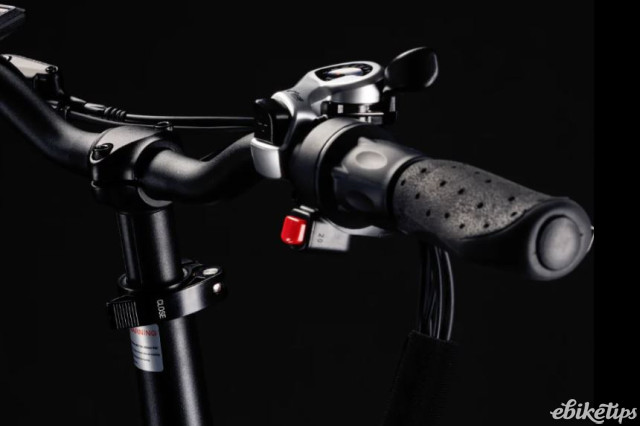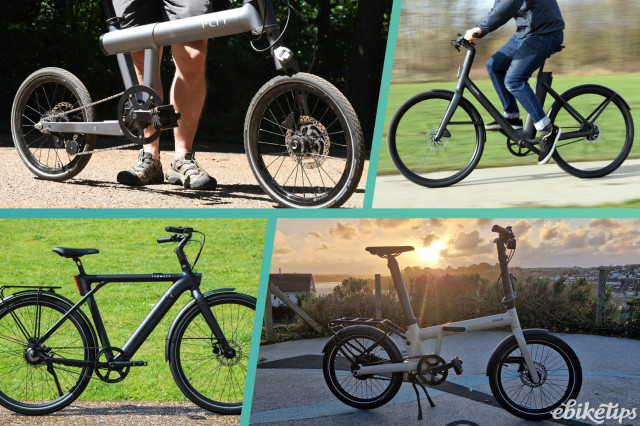Review: Eskute Voyager

Overview
- Great price
- Good 48V hub motor power
- Basic pre-load and lockout on fork
- Poor rear brake
- Gearing too high
- No rear light
The Eskute Voyager is a budget e-MTB-cum trail bike that actually shares quite a number of components with Eskute's city e-bike, the Wayfarer (which we reviewed here). No doubt that's one factor helping Eskute keep the RRP down to a reasonable £999 - and there are often discounts and special offers around making Eskute e-bikes even cheaper.
Most notably the Voyager has the self-same Bafang rear hub motor as the Wayfarer (the RM G020.250 to be precise), the same Shimano budget seven speed Shimano Tourney derailleur setup, the same cable-operated iZoom disc brakes, same front LED light and same handlebar display and controls.
Differences include the obvious (the Voyager doesn’t have the pannier rack or rear light of the Wayfarer and has smaller 27.5" wheels with 2.1 inch wide knobblies) and the less obvious (it has a bigger battery - 480Wh vs 360Wh and runs at 48volts vs 36 volts).
The reason that the Voyager appears at ebiketipshere and not at our sister site offroad.cc is that it's one of those off-road capable e-bikes that blurs the line between 'proper' MTBs and trail bikes. The geometry gives a fairly comfortable and upright riding position, there are (very) budget forks, a low-end (but reliable) rear hub motor with pedal movement sensing to activate the motor.
So, the Voyager is never going to challenge a mid-drive e-MTB with hydraulic disc brakes in the climbing and handling stakes. But then again it costs less than half as much as even the lowest priced mid-drive machines.
Given the limitatons imposed by the low price let's see how it looks both spec-wise and out on the trail.
Spec and build
Despite the budget approach, Eskute look to have made a thoughtful effort to put the limited manufacturing budget to good effect. There is a very strong looking frame at the heart of the bike and the integration of the battery into the frame looks smooth and is even more impressive once you have taken the battery in and out of the frame a few times. The key-operated lock feels positive and there is no movement or rattle once it's locked into the frame. Isn't that the least you'd expect? Well, there are plenty of budget e-bikes out there with rattly batteries and frame-integrated batteries are certainly not the sign of a manufacturer looking to cut costs are every corner.
The frame also has attachment points for a full length rear mudguard, though guards aren't supplied. The frame is sized at 16.5 inch / 42cm, which I found just right for my 5’ 8” height and it gave a comfortable ride position, albeit slightly leant forward in line with its sporty leisure credentials. There’s around 6” / 15cm height adjustment on the seatpost which will give a very low seat height for very small riders (I measured it at around 80cm off the ground). Eskute say that the bike is suitable for riders between 160 – 200cm (5’3″to 6’7″).
'Does what it says on the tin' might be a cliched way of describing your average Bafang rear hub motor, so you would expect Eskute's choice in this area to be a dependable rather than a spectacular performer. However, they have matched the Bafang motor with a 48V battery and 48V control electronics which should enable more power delivery to the motor than on the city-orientated 36V Wayfarer, even though the Voyager uses the same motor as its urban cousin. (Important note; the details on the Eskute website at the time of writing show a 36V, 450Wh battery spec allied with a 48V controller and charger on the Voyager. This is confusing and not in line with the 48V battery supplied with the test bike - double check with the manufacturer if considering purchasing).
A bit more disappointing is the 7-speed drive train; not because of the fact it's a budget choice, as you wouldn't expect anything else on this price of bike, but the gear ratios are just the same as on the city bike when you would really expect them to be lower. See the following section for how they performed in the field.
iZoom is not a name I had heard of before testing the Voyager, though they pop up on internet searches as manufacturers of both very low priced mechanical and hydraulic disc brakes. Cable operated disc brakes seem to range from fairly ineffectual to viciously powerful and everything inbetween, depending on just how they are setup and the components used, so it was hard to know what to expect from those on the Voyager. Again, read on to see how they performed in the real world.
All other aspects look to be in line with the price tag; a budget suspension fork, LCD display with electronic horn and light switch, friction fit rubber grips and a well-padded own-brand seat. Sturdy-looking, metal-caged platform pedals are a nice feature.
Climbing range and handling
The extra volts certainly translate to extra hill-climbing ability. Despite having the same motor as the Wayfarer, the Voyager was notably quicker up the steepest tarmac climb in my local area. It's a 15% grade climb, so it would certainly work the motor hard on any kind of e-bike; the handy Watts output field on the LCD display showed the Voyager consistently offering peak power of 930 watts compared to the Wayfarer's 730W or so up the same climb. The 48V system - even using the same motor - is shown to have a clear advantage.
In steep off-road conditions the limitations of the powerful hub plus cadence sensor becomes apparent though; the pedal assist system means to get the maximum power from the system you need to keep up a reasonably fast cadence. Drop below a certain cadence, as is easily done on steeper uneven trails, and the motor starts to moan and groan and on very steep sections delivers next to no power. This isn't a criticism of this particular e-bike but common to all hub motor, cadence sensor sytems I've tried. Pricier torque sensor mid-drives simply work on different mechanical principles so they can deliver immediate power in response to simple pedal pressure (rather than movement). Having said all that, lower gearing on the Voyager would probably give a real boost to performance, allowing the rider to keep that cadence at a reasonable rate, and speed and motor power to be maintained.
The really big question mark though was over the brakes; these needed quite a bit of force on the brake levers to be effective even though they improved over time (especially the front brake). The rear brake remained a little spongy and ineffective but when both were used together there was certainly a decent amount of stopping power. Perhaps time or a change of brake pads would lead to a marked improvement.
Other aspects of the Voyager performed well, from the powerful, hardwired front LED to the sturdy kickstand, reliable gear changing and the grippy but freerolling Kenda 2.1 inch wide knobblies.
The competition
We have already reviewed the E-trends Trekker which looks to occupy a similar off-road budget niche in the UK market and by comparison the Voyager knocks spots off it, both in terms of the amount and smoothness of power delivered. Aside of the bigger battery on the Voyager, both bikes look similar on paper, which just shows how attention to detail in setting up the control and electronics system can give a big performance boost.
Whilst the Voyager isn't as sophisticated in terms of power delivery as Halford's Carrera Vengeance E, it certainly trumps it in terms of bang for your buck, especially as the Vengeance has crept up in price by a couple of hundered pounds since we reviewed it. Away from the bargain basement of eBay sellers the only other real competition comes from Decathlon's Rockrider, which matches the Voyager on price but has a smaller 380Wh battery (though it does look to have more sensible gearing).
So the Voyager certainly looks to be near the head of the pack of sub-£1,000 leisure e-MTBs. Sure, you might have to replace parts more often than on pricier bikes that also come with longer guarantees (the Voyager has a one year guarantee). But even then none of the budget components will break the bank to replace and even replacement batteries are very reasonably priced at £189.
To use another cliche about the Eskute Voyager: at £999, what's not to like?
















